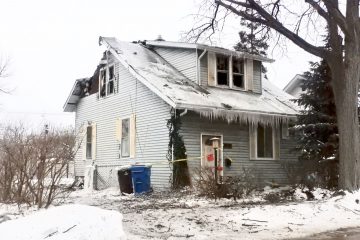DTE claims no PCB at fire site

DTE Regional Director of Operations Ryan Stowe apologized to commissioners for “any inconvenience.”
Oct. 8, 2017 PLYMOUTH EAGLE.
Plymouth Michigan News
Don Howard
Staff Writer
The subject of safety and PCB contamination was not addressed by officials from DTE Energy who spoke to the Plymouth City Commission during their regular meeting last week.
The presence of dangerous fumes and contamination was not mentioned during discussion of the fire and explosion that shut off power to more than 4000 residents for two days and destroyed the main electrical sub-station. Contamination was a critical concern for the fire chiefs and firefighters alike who responded to the fire, according to several sources in the area departments.
Forty-three area firefighters and a 12-man Wayne County Hazardous-Material team attended the explosion and fire when black smoke from burning oil could be seen for miles. The source of the fire, according to DTE spokesmen, was a decades-old power transformer that sat outside of the sub-station and next to the Plymouth Cultural Center. Firefighters were able to contain the transformer fire, and protect the adjacent sub-station building and Cultural Center. The oil capacity within the transformer, said to be up to 1000 gallons, remains unknown.
Regional Director of Operations Ryan Stowe along with Senior Manager Satvir Diol, apologized to commissioners for “any inconvenience.” Stowe described the problem as an “unspecific transformer failure.” Plymouth Mayor Dan Dwyer, who extended the invitation, thanked the executives for the fast response and round-the- clock work at the sub-station site on Farmer Street.
Two days after the fire, workers in Haz-Mat protective gear were observed at the site shoveling heavy ash and oil soaked debris from the site of the fire into black, 50-gallon sealed drums. The drums were clearly labeled as containing PCB, (poly-chlorinated biphenyls), a probable human carcinogen which cannot by law be manufactured in the United States.
Describing the sub-station as an “older dying system,” Stowe told commissioners trees cause 70 percent of power outages. He said that crews would be working to replace all the damaged equipment on the grid during the next six months and DTE is considering a future re-build of the facility that would modernize and replace all components and increase electrical capacity in the area.
Commissioner Joe Valenti asked if DTE “…was just patching and old infrastructure with a bigger patch.” Stowe responded, “No, there’s a lot of new stuff there.”
“I thought it was good to see the regional director and engineer come to meet with us, but I felt the answers were pretty thin,” Valenti said after the meeting.
In a later interview, Stowe and Diol had only scant information regarding any possibility of contamination or danger to residents and referred questions to their corporate communications department.
Sources close to the issue reported that DTE was also very concerned about possible contamination and collected 55 soil samples outside the fenced grid-area for analysis to be performed by a testing company.
In a later prepared statement, DTE spokesperson Randi Berris said, “DTE Energy follows all federal and state environmental regulations. The EPA has been involved since the day of the fire in Plymouth and has been satisfied with all our samples and the data we have provided.”
The statement added, “Because it takes time to receive the analytics back from the samples we tested, it’s a federal requirement to label the drums as “PCB.” That is out of an abundance of caution and does not mean that any PCBs are actually present. And in fact, there was no detectable PCBs once the testing was complete. The cleanup crew was wearing the protective gear because they were working in dirt and soot – not because of any concern about contaminants.
“Working with EPA, DEQ and the City of Plymouth, we checked the storm drains multiple times and saw no impact from the oil.”
Northville-Plymouth Fire Chief Steve Ott said that during the fire the Wayne County Haz-Mat team conducted air-monitoring samples in the residential area and there were no signs of PCBs.
Ott said the 15-sets of firefighter turnout gear were given to DTE for testing even though there were no signs of visible contamination, oil or residue.
“Out of an abundance of caution and at the fire department’s request, we collected and ran samples on the fire department gear-everything came back non-detect for PCBs. Testing of the transformer that caught fire did not show detectable PCB content,” Berris said. Stowe said DTE received the official results of the after the cleanup occurred.
“The fire was not a PCB hazard and multiple soil samples proved the PCB levels to be under 50 PPM, the EPA threshold.”
Plymouth Voice.



